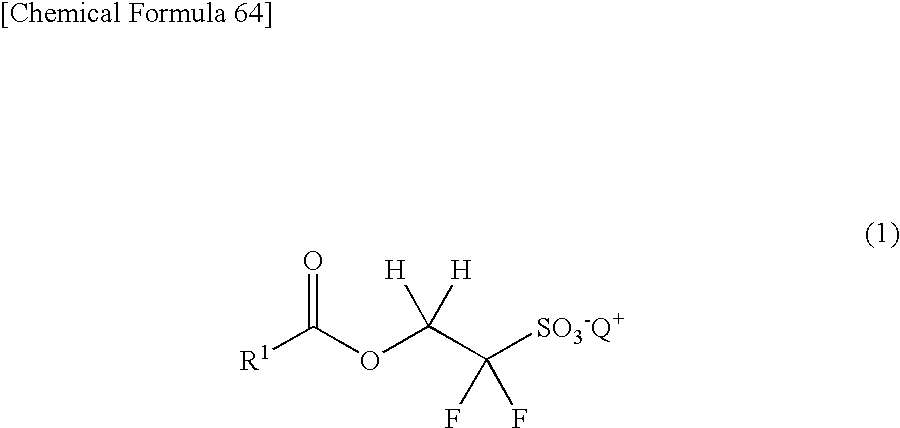Compound for photoacid generator, resist composition using the same, and pattern-forming method
a generator and photoacid technology, applied in the field of photoacid generators, can solve the problems of low pattern dimension precision, chemically amplified resist inferior in flatness of the film surface, and the electric characteristics of the device tend to be damaged, so as to achieve stable structure, adjust solubility and compatibility, and high solubility of resist solvents and compatibility
- Summary
- Abstract
- Description
- Claims
- Application Information
AI Technical Summary
Benefits of technology
Problems solved by technology
Method used
Image
Examples
synthesis example 1
Production of (2-bromo-2,2-difluoro)ethyl valerate
[0176]
[0177]A 200 mL reactor was charged under nitrogen with 6.0 g (50.0 millimoles) of valeryl chloride and 90 mL of THF (dehydrated), followed by putting it in an iced bath. There 11.3 g (purity: 93%, 65.3 millimoles / 1.31 equivalents) of 2-bromo-2,2-difluoroethanol was added, and 7.1 g (70.0 millimoles / 1.4 equivalents) of triethylamine was added dropwise. After the dropping, stirring was conducted at room temperature for 18 hours. Then, 35 mL of water was added, and extraction was conducted two times with 100 mL of diisopropyl ether. The obtained organic layer was further washed with diluted hydrochloric acid, sodium bicarbonate water and brine, followed by removing water with sodium sulfate, filtration, and then distilling isopropyl ether off, thereby obtaining 9.9 g of the target (2-bromo-2,2-difluoro)ethyl valerate. Upon this, purity was 89%, and yield was 72%.
Properties of (2-bromo-2,2-difluoro)ethyl valerate
[0178]1H NMR (CDCl3...
synthesis example 2
Production of sodium 2-valeryloxy-1,1-difluoroethanesulfinate
[0180]
[0181]A 200 mL container was charged under nitrogen with 9.7 g (purity 89%, 35.4 millimoles) of (2-bromo-2,2-difluoro)ethyl valerate, 40 g of acetonitrile, 5.9 g (70.7 millimoles / 2.0 equivalents) of sodium hydrogencarbonate, 8.7 g (50.1 millimoles / 1.5 equivalents) of sodium dithionite, and 40 g of water, and stirring was conducted at 60 degrees for 1.5 hours and at 80 degrees for 16 hours. Furthermore, 5.9 g (70.7 millimoles) of sodium hydrogencarbonate and 8.7 g (50.1 millimoles) of sodium dithionate were added, and stirring was conducted at 80 degrees for 94 hours. The reaction liquid was extracted six times with 40 mL of acetonitrile, and the solvent was distilled out of the obtained organic layer. Furthermore, it was washed with 200 mL of diisopropyl ether, followed by filtration and drying solid, thereby obtaining 6.74 g of the target sodium 2-valeryloxy-1,1-difluoroethanesulfinate. Upon this, purity was 28%, an...
synthesis example 3
Production of sodium 2-valeryloxy-1,1-difluoroethanesulfonate
[0184]
[0185]A 100 mL reactor was charged with 6.6 g (purity 28%, 7.3 millimoles) of sodium 2-valeryloxy-1,1-difluoroethanesulfinate, 60 mL of water, 0.0047 g (0.014 millimoles / 0.0019 equivalents) of sodium tungstate dihydrate, and 1.9 g (16.4 millimoles / 2.25 equivalents) of 30% hydrogen peroxide solution, followed by stirring at room temperature for 1.5 hours. The reaction liquid was heated under reduced pressure, followed by distilling volatile component to dryness, thereby obtaining 6.6 g of the target sodium 2-valeryloxy-1,1-difluoroethanesulfonate. Upon this, purity was 26%, and yield was 88%.
Properties of sodium 2-valeryloxy-1,1-difluoroethanesulfonate
[0186]1H NMR (DMSO-d6): δ 4.52 (t, J=15.6 Hz, 2H; CH2), 2.34 (t, J=7.6 Hz, 2H; CH2), 1.51 (quintet, J=7.6 Hz, 2H; CH2), 1.28 (sextet, J=7.6 Hz, 2H; CH2), 0.85 (t, J=7.6 Hz, 3H; CH3).
[0187]19F NMR (DMSO-d6) d -113.70 (t, J=15.6 Hz, 2F; CF2).
PUM
| Property | Measurement | Unit |
|---|---|---|
| wavelength | aaaaa | aaaaa |
| wavelength | aaaaa | aaaaa |
| optical path length | aaaaa | aaaaa |
Abstract
Description
Claims
Application Information
 Login to View More
Login to View More - R&D
- Intellectual Property
- Life Sciences
- Materials
- Tech Scout
- Unparalleled Data Quality
- Higher Quality Content
- 60% Fewer Hallucinations
Browse by: Latest US Patents, China's latest patents, Technical Efficacy Thesaurus, Application Domain, Technology Topic, Popular Technical Reports.
© 2025 PatSnap. All rights reserved.Legal|Privacy policy|Modern Slavery Act Transparency Statement|Sitemap|About US| Contact US: help@patsnap.com



